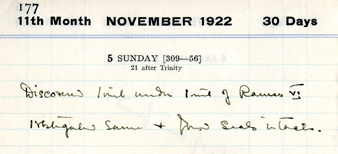
None of
this material may be reproduced in any form without permission from
Griffith
Institute, Oxford OX1 2LG
Concept & Direction: Jaromir
Malek
Design: Jonathan Moffett
Scanning, transcription and
editing:
Sue Hutchison,
Elizabeth Fleming, Diana Magee, Kent Rawlinson, Lindsay Allen, Alison Hobby,
Jenni Navratil, Hana Navrátilová, Ana I. Jimenez, Andrew Hogan, Jaromir Malek

Harry Burton's photographs of the tomb of Tutankhamun
Harry Burton's photographs showing work in Tutankhamun's tomb
Prints of Harry Burton's photographs for sale
Photographs by anonymous photographers showing scenes outside the tomb
John Ross's colour photographs of objects from the tomb of Tutankhamun
For connoisseurs of photography:
Tutankhamun: Anatomy of an Excavation is ambitious in its scope but simple in its aims: to make the complete records of Howard Carter's excavation of the tomb of Tutankhamun available on these web pages. It is astonishing, but no longer acceptable, that some eighty years and thousands of articles, hundreds of books, and dozens of exhibitions after the discovery of the tomb, this most famous event in the history of Egyptian archaeology has not yet been fully published. The documentation is presented in its original form and all, scholars, interested members of the public and school students, can consult it. We hope that this will help bring the knowledge and love of ancient Egypt to everybody.
Carter assigned numbers 1 to 620(123) to the 5,398 objects found in the tomb
(many of these numbers are groups of items):
Nos. 1 to 3 were from outside the tomb and the Staircase,
No. 4 was the first doorway,
Nos. 5 to 12 were from the Descending Passage,
No. 13 was the second doorway to the Antechamber,
Nos. 14 to 170 were from the Antechamber (No. 28 was the third doorway
to the Burial Chamber),
No. 171 was the fourth doorway to the Annexe,
Nos. 172 to 260 were from the Burial Chamber (No. 256 was the King's mummy),
Nos. 261 to 336 were from the Treasury,
and Nos. 337 to 620(123) were from the Annexe.
Tutankhamun: Anatomy of an Excavation can be searched in several different ways:
the database search
(searches the "description" field of all items in the database and finds relevant records)
the extended database search
(searches the "description" field of all items in the database, including
sections of the main list and photographs, plus the texts on object cards)
You can also search the rest of the Griffith Institute website
(this includes the "description" field on objects cards but not the full text of the object cards)
Harry Burton's photographs (you may also use the search option above):
Howard Carter's excavation and pocket diaries (transcripts and
scans):
Arthur Mace's excavation diaries (transcripts and scans):
Howard Carter's notes made in preparation of the complete publication of the tomb.
A Gallery of drawings made by Carter during the examination of Tutankhamun's mummy.
Howard Carter's copies of A. H. Gardiner's recordings of inscriptions on some objects from the tomb of Tutankhamun. Carter's Notebook TAA i.2.7
Notes on various aspects of the tomb and its contents, filed with object cards:
Alfred Lucas's notes on conservation of objects from the tomb of Tutankhamun:
Miscellaneous